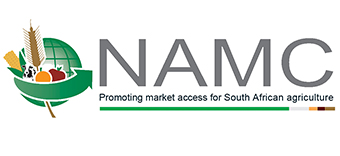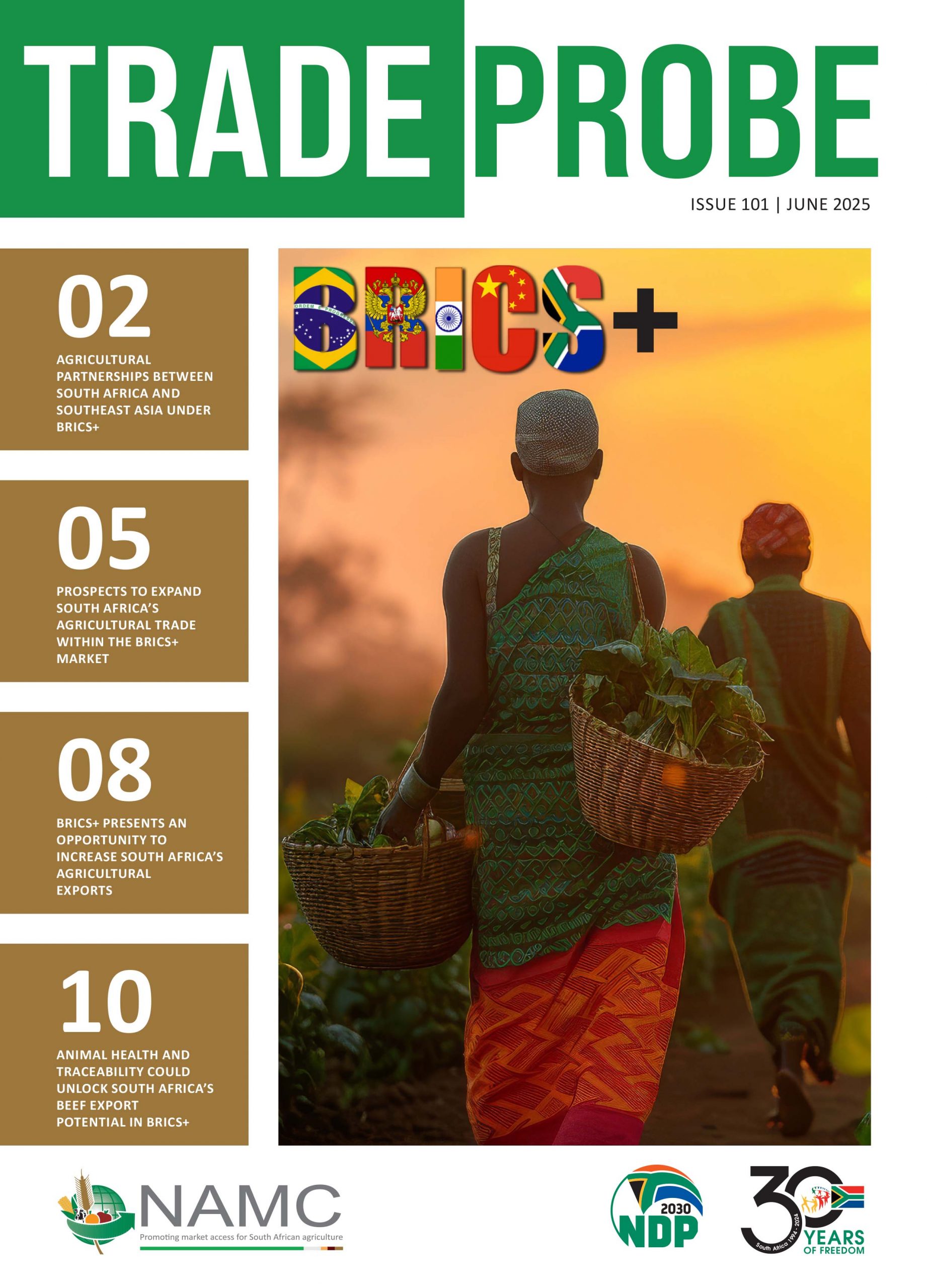SOUTH AFRICAN CITRUS EXPORTS TO THE EXPANDED BRICS+: OPPORTUNITIES, CHALLENGES AND STRATEGIC PATHWAYS
By: Bernard Manganyi and Thulani Ningi
Introduction
South Africa’s citrus industry plays a vital role in the country’s agricultural economy, generating significant income and employment. In 2023, citrus exports earned R33.9 billion (about $1.8 billion) and supported substantial jobs (CGA,2024). This contribution makes citrus one of the top agricultural exports. South Africa aims to export 260 million cartons of citrus by 2032. BRICS is increasingly emerging as a formidable global force, accounting to 42% of the world’s population of over 3.6 billion people and occupying 26% of the world’s landmass. Together, BRICS countries account for approximately 30% of global GDP (BRICS Business Council, 2024). New members such as Egypt, Ethiopia, Iran, the UAE, and Indonesia offer South Africa more options to diversify its citrus markets. However, trade barriers, logistical issues, and geopolitical tensions can complicate access to these markets (WTO and ITC, 2023). This article examines the current export situation, identifies challenges, and suggests strategies for South Africa to increase its citrus trade benefits within the BRICS+ framework. The article focuses on citrus export data from 2018 to 2024 to ensure a relevant and updated analysis that reflects recent trade dynamics, including pre- and post-COVID-19 impacts, shifting geopolitical relationships, and the expansion of the BRICS bloc. This seven-year (2018-2024) window captures both structural trends and short-term fluctuations, offering a robust basis for evaluating emerging market potential and policy implications within the BRICS+ framework.
The current citrus export landscape within BRICS+
South Africa’s citrus trade within BRICS+ countries can be grouped into three tiers based on export volume and potential as shown in Table 1. The top-tier markets include countries such as Russia, the UAE and China. In 2024, Russia imported about $149.8 million of citrus products, up from $114.2 million in 2018, despite ongoing Western sanctions (Trade Map, 2025). These exports are largely redirected from the EU. The UAE, serving as a key redistribution hub through the Jebel Ali Port, received $163.9 million in citrus in 2024. In contrast, China’s imports declined from $148.6 million in 2018 to $87.7 million in 2024, due to strict phytosanitary regulations and rising domestic competition.
Table 1: South African Citrus Exports to BRICS+ (2018–2024, USD thousand)
| Importers | 2018 | 2019 | 2020 | 2021 | 2022 | 2023 | 2024 | Change (2018-2024) | |
| Top-tier | UAE | 94 330 | 88 876 | 126 703 | 138 805 | 136 595 | 172 189 | 163 860 | 74% |
| Russia | 114 236 | 91 600 | 125 261 | 129 215 | 138 655 | 146 267 | 149 829 | 31% | |
| China | 148 563 | 103 556 | 96 146 | 119 431 | 132 693 | 106 994 | 87 664 | -41% | |
| Mid-tier | Saudi Arabia | 83 373 | 87 342 | 74 381 | 77 722 | 64 930 | 56 630 | 62 969 | -24% |
| India | 8 052 | 7 423 | 8 652 | 16 805 | 21 496 | 24 230 | 27 346 | 240% | |
| Indonesia | 3 717 | 3 348 | 915 | 2 142 | 2 119 | 3 037 | 3 327 | -10% | |
| Low-tier | Brazil | 0 | 0 | 116 | NA | 81 | 111 | 108 | 0% |
| Ethiopia | 64 | 93 | 22 | 49 | 72 | 71 | 78 | 22% | |
| Iran | 58 | 0 | 71 | 80 | 34 | 114 | NA | 0% | |
| Egypt | 0 | 0 | 0 | NA | NA | NA | NA | NA |
NA-Missing data
Source: Trade Map (2025)
The mid-tier or emerging markets such as India offer growing potential. Citrus exports to India grew from $8.1 million in 2018 to $27.3 million in 2024 due to a rising middle class and changing consumer preferences. However, a 30% import duty on oranges is a significant barrier, although ongoing talks under the SACU-India framework offer hope for change. Saudi Arabian citrus imports decreased from $87.3 million in 2019 to $63 million in 2024. This decline may indicate a need for South Africa to adapt to local policies and tax changes. Iran’s trade is unstable due to geopolitical issues, but it offers potential for South Africa to develop relationships. The lower-tier or underutilized markets like Brazil, Egypt and Ethiopia remain largely untapped. Despite being a BRICS member, Brazil imported only $111,000 worth of citrus in 2023 due to protective trade rules. This indicates an opportunity for South Africa to engage with Brazil more actively. Egypt shows minimal engagement, and Ethiopia imported only $78,000 in 2024. These figures suggest that there is untapped potential in these markets that South Africa can explore further
Challenges Facing South African Citrus in BRICS+ Markets
South African citrus exports face various challenges in BRICS+ countries. For example, China has strict cold treatment rules that increase costs by 15-20%. India requires fumigation for certain citrus types, which raises export costs. Russian customs inspections can cause delays and administrative challenges. Geopolitical issues related to sanctions on trade with countries such as Russia and Iran complicate payment processes and increase costs. Additionally, U.S.-China tensions can lead to secondary sanctions affecting re-exports. Port congestion, especially at Durban Harbour in South Africa, can cause delays of up to three weeks during peak seasons, which risks product quality (CGA, 2024).
Strategic Pathways for Market Expansion and Risk Mitigation
To fully capitalize on BRICS+ trade opportunities, South Africa must adopt differentiated strategies for each market. In Russia, it is essential to strengthen alternative payment systems and diversify logistical routes, including transit through Türkiye and Iran, to avoid chokepoints. For India, concerted lobbying for tariff reductions under the SACU-India trade talks is necessary, while simultaneously positioning South African citrus as a premium product that can compete with Spanish imports. The UAE should be leveraged as a direct market and as a logistical hub facilitating entry into harder-to-reach regions such as Saudi Arabia and Iran. Strengthening partnerships with ports and cold-chain logistics operators in Jebel Ali can reduce spoilage and improve time-to-market. In the case of China, long-term efforts should focus on negotiating relaxed phytosanitary requirements, potentially under BRICS agricultural cooperation platforms. Assuming the 2025 BRICS chairmanship, Brazil provides an opportunity to address Mercosur protectionism through bilateral trade engagements. Moreover, intra-African opportunities should not be overlooked. Once fully implemented, the African Continental Free Trade Area (AfCFTA) offers tariff-free access to markets such as Ethiopia and Egypt, but this requires significant investment in cold-chain infrastructure and regional logistics.
Conclusion
As BRICS+ evolves into a powerful global trading bloc, South Africa’s citrus sector is well-positioned to benefit, if it can strategically overcome trade, logistical and regulatory hurdles. By aligning export strategies with specific market conditions, lobbying for better trade terms, and investing in infrastructure, South Africa can not only safeguard but also expand its citrus footprint across the Global South. With the right interventions, BRICS+ could be the key to a more resilient and diversified citrus export future.


